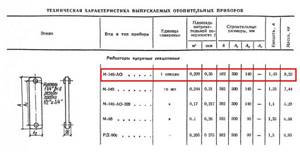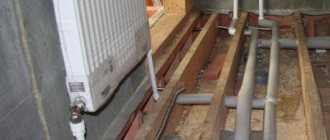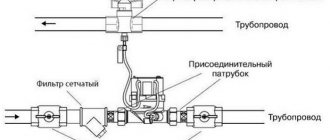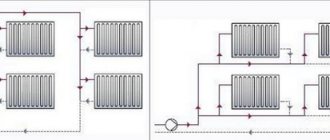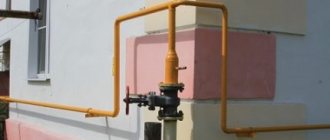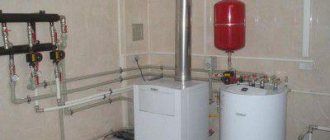Changes in 2019 that affected heating
When calculating heating payments in apartment buildings, some parameters have changed:
- There were two heating options, it was divided into 2 categories: individual and communal.
- We have developed special formulas for calculating those square meters and rooms that are not heated, and for residential areas with autonomous heating.
- Individual calculation of heating payments has appeared in multi-apartment buildings, which are only partially equipped with heat meters.
Also, for a more detailed calculation, new indicators were introduced that affect the amount of payment. Such as the area of common areas and the amount of Gcal of heat consumed. This value is the sum of the indicators that were taken from individual heat metering equipment or installed on the heating systems of the owners of radiator distributors.
Connecting heat supply in an apartment building
Before organizing heat supply to non-residential premises, it is necessary to carry out a primary analysis of the characteristics of the building.
To complete this step correctly you need:
- Select the thermal operating mode based on the purpose of the room.
- Calculate heat supply using dimensional indicators as a basis.
- Decide which coolant will be used.
Based on the information obtained as a result of the mentioned procedures, the method by which the room will be heated is selected.
Then everything is done like this:
- Activities are carried out as a result of which it becomes possible to supply coolant to non-residential areas, that is, the necessary communications are supplied.
- Do not forget that heating does not appear by itself. For everything to work, you need to conclude an agreement with heat suppliers for its supply.
Important. It is worth noting that any project of an administrative or industrial building should begin with an analysis of possible types of heating.
When assessing a room, special attention should be paid to its heat losses. If calculations show that they are too large, then you can resort to additional thermal insulation by installing it on the heated area. In this way, you can achieve a tangible effect.
How to calculate the amount yourself
You can calculate the amount of payment for heating in your apartment yourself. But before that, consider some factors:
- Determine how many months a year the payment for heat occurs. Only for the period when hot water is supplied to the batteries or throughout the calendar year.
- Find out if your apartment building has a communal heat meter installed.
- Find out whether your living space is equipped with a separate heat meter or its own radiator distributors.
- Determine how the heating system in your living space is filled with hot water. Via the central city system or through special equipment installed in your home.
Based on these parameters, you can use certain formulas to calculate payments for heating an apartment.
Calculation of heat load for space heating
Name of object: Newspaper editorial office
Content:
- Initial data
- Calculation of heat load for heating
- Technical conclusion
- List of normative, technical and special literature
- Complete information on calculating thermal loads
Calculation of heat load approval at MOEK
Find out in detail
What are the rules for calculating payments for heat?
Be guided by the parameters that you have defined for your home and use the ready-made formula to calculate by category:
- When there is no common house heat meter (DHMU), and payments for heat supply are charged only during the months of the heating season.
- If there is no general income tax, and payments are extended over the entire calendar year.
- The house is connected to an ODPU, but separate meters are not installed in any of the premises of the building.
- The building has an ODPU installed, the apartments are partially equipped with separate devices for calculating heat energy.
If your apartment is located in a building in which ODPU are not connected, and the payment is assigned only during the heating period, the heat energy is calculated according to the standards. This is a fixed amount of energy that is required to heat 1 square meter. meters for 30 days. Standards vary depending on the region; they are adopted and approved by local leadership, taking into account climatic conditions. In this case, you can use the following formula:
P = Plz x Np x Tt
Plzh - housing area. NP - consumption standard. Тт —heat tariff.
For buildings without DPPU, in which payments are spread over 12 months, the calculation includes the coefficient of frequency of payment for utilities for heat energy. The coefficient is equal to the number of payments for the heating season divided by 12 months. And the calculation will be made according to the following formula:
P = Pl x Np x Kf x Tt
Where Kf is the calculated coefficient for monthly accounting.
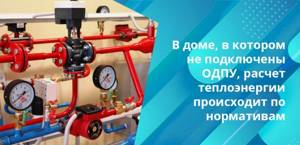
Payment for heating in non-residential premises of MKD
Non-residential premises include premises that are not housing and common property of the owners of an apartment building, and are not intended for the residence of citizens. These include retail establishments, mini-bakeries, dry cleaners, ticket offices, hairdressers located in the house.
The owners of such facilities must pay for utilities, including heat. In the absence of flow meters or the impossibility of installing them, the owners pay for heat according to the occupied area and the consumption of energy resources for general house needs.
Commercial structures often convert basements and ground floors into non-residential structures. After such registration, the calculation of energy supply will be determined as for non-residential spaces of the house.
If re-registration has not occurred, then the ground floors and basements will be considered the common property of the apartment building. The resource supply will be paid by the owners and users of all premises of the house for the entire period of absence of users.
Residents need to know what uninhabited objects are in the house, how they are used and how payments for heat supply are calculated.
Many controversial situations arise in the event of the absence or dismantling of batteries in various objects of an apartment building.
The owners of the living space believe that in the absence of radiators, the heat supply is not consumed, and there should be no payment. Resource supply organizations require payment on the basis that the system heats the entire house and ensures the required temperature in the entire house.
The practice of considering cases in courts on this issue is very contradictory.
A decision in favor of the resource supplying organization is made if the room is heated by uninsulated main pipes, or the dismantling of the radiators has not been agreed upon with anyone.
A decision in favor of citizens is made when the main pipes are insulated, and the project does not provide for heating of this facility.
The decision for each specific case is unknown in advance, even if there are precedents.
Additional calculation formulas
Meters for calculating heat energy in an apartment building are installed upstream of the building. The device shows how much heat is supplied to the apartments of the entire building. Heat is calculated proportionally for all apartments. The calculation is carried out as follows:
P = (Rebt + (Plzh x (Ot - ∑Rebt)) / Plob) x Tt
Plzh is the area of the apartment. Floor area - the total area of residential and non-residential premises in a building. From - the volume of heat energy according to the ODPU readings when paid during the heating period or according to the average heat energy indicator by month for the previous year. Tt is the tariff set for heat energy. Total - the volume of heat that is needed to heat the entire living space. ∑Tot is the volume of all heat energy consumed in residential and non-residential premises of a high-rise building.
To calculate the Obt indicator, you also need a formula:
Obt = Plz x (From / (Plob - Plind + Ploi))
Ploi - the area of those premises that are for common use. Plind is the area of residential and non-residential rooms in which there are no heating devices or their own heaters are installed.
The calculation is carried out according to the following formula:
∑Obt: From/ (Plob + Ploi) x Plob
If in one residential building an individual metering device (IMU) is installed in at least one of the apartments, it is included in the calculation of the total payment for heating. To calculate payments in houses where IPU is installed in several apartments, the same formula is used as for houses with ODPU, but without IPU.
For those premises in which there is no IPU, the Obt indicator is calculated as follows:
Obt = Plzh x (∑ObtIPU / ∑PlzhIPU)
∑ObtIPU - the total amount according to the indications of the IPU, if the calculation and accrual of payment occurs during the heating season. Or by the average monthly heat volume for the previous year. ∑PlzhIPU - area of all rooms with IPU.
It’s not easy to count the first time, but even the second time, it becomes clear what indicator and what meter readings should be inserted where
Application of calculation methods
It should be noted that the choice of a specific calculation method for determining the volume of consumption of a communal resource for each specific case must be agreed with the relevant resource supplying organization and the agreements reached must be recorded in the relevant contracts.
The calculation of the amount of payment for a utility service consumed in non-residential premises not equipped with metering devices is calculated as the product of the consumed volume of a utility resource, determined by calculation, by the tariff for the specified utility resource established by the state authority of a constituent entity of the Russian Federation for the corresponding category of consumers.
Author: Nifontov D.Yu.
ku 71pu 5water disposal 30
Did you like the article?
Subscribe to stay updated on current articles and the most important housing and communal services news.
What temperature should be maintained in apartments?
Heating standards in apartment buildings during the cold season:
| Room type | Optimal temperature in degrees Celsius | Permissible temperature in degrees Celsius |
| Living room | 20-22 | 18-24 |
| Living room in regions with an outside temperature of -31°C or lower | 21-23 | 20-24 |
| Kitchen | 19-21 | 18-26 |
| Corridor between apartments | 18-20 | 16-22 |
| Toilet | 19-21 | 18-26 |
| Bathroom | 24-26 | 18-26 |
| Lobby, landing | 16-18 | 14-20 |
| Pantry | 16-18 | 12-22 |
In the warm season, the norm for living rooms is optimally 22-25°C, and acceptable - 20-28°C.

If the temperature in your apartment during the heating season does not meet the established standards, you can contact the service company or utility service. They are required to investigate and obtain evidence. In this case, heating payments will be reduced. But such a solution can be called a half-measure, and it will suit few people, because the apartment will still remain uncomfortable living conditions.
Calculation of cast iron heating radiators
| Item no. | Floor no. | Estimated temperature graph | Radiator type | Number of radiators | Number of sections |
| 1 | 1 | 95.0-70.0 oC | Cast iron M-140-AO | 4 | 7 |
| 2 | 1 | 95.0-70.0 oC | Cast iron M-140-AO | 1 | 8 |
| 3 | 1 | 95.0-70.0 oC | Cast iron M-140-AO | 1 | 9 |
|
| Designer's Handbook “Internal sanitary installations” (I.G. Staroverov, 1975), table 12.1, page 42 |
How to reduce payments
To reduce the amount of monthly payments for heat, the only way is to install individual heat meters. But before that, you may encounter several problems:
- Obtaining permission to install an IPU is a time-consuming process. In order for the installation to be approved, the technical specifications must be confirmed or improved. Based on them, the appropriate type of meter is selected.
- To regularly pay for heating using an individual meter, you need to send meters for verification in a timely manner. To carry it out, the meter is dismantled and reinstalled, which entails additional costs. If the verification takes place during the heating season, then payment for heating the apartment for a time without IPU is carried out according to the established standard. Therefore, it is better to return meters in the summer, although there may be long queues at this time.
- Expensive installation of IPU. Payment for the installation of one meter can reach 25 thousand rubles. Some companies charge a separate fee for dismantling. In addition, verification is also paid. And if the meter does not pass verification by the technical service or breaks down, it must be replaced in a timely manner.

Despite the complexity and large investment during initial installation, using a custom appliance can significantly reduce your monthly heating bills.
List of normative, technical and special literature
Heat consumption is calculated in accordance with and taking into account the requirements of the following documents:
- Methodological guidelines for determining the consumption of fuel, electricity and water for heat production by heating boiler houses of municipal heat and power enterprises (SUE Academy of Public Utilities named after K.D. Pamfilov, 2002);
- SNiP 23-01-99* “Building climatology”;
- Calculation of central heating systems (R.V. Shchekin, V.A. Berezovsky, V.A. Potapov, 1975);
- Designer's Handbook “Internal Sanitary Installations” (I.G. Staroverov, 1975);
- SP30.13330 SNiP 2.04.-85* “Internal water supply and sewerage of buildings.”
- “Technical regulations on the safety of buildings and structures.”
- SNiP 23-02-2003 “Thermal protection of buildings”
- SNiP 23-01-99* “Construction climatology”
- SP 23-101-2004 “Design of thermal protection of buildings”
- GOST R 54853-2011. Buildings and constructions. Method for determining the heat transfer resistance of enclosing structures using a heat meter
- GOST 26602.1-99 “Window and door blocks. Methods for determining heat transfer resistance"
- GOST 23166-99 “Window blocks. General technical conditions"
- GOST 30971-2002 “Mounting seams of junctions of window blocks to wall openings. General technical conditions"
- Federal Law of the Russian Federation of November 23, 2009 N 261-FZ “On energy saving and increasing energy efficiency, and on introducing amendments to certain legislative acts of the Russian Federation.”
- Order of the Ministry of Energy of Russia dated June 30, 2014 N 400 “On approval of the requirements for conducting an energy survey and its results and the rules for sending copies of the energy passport drawn up based on the results of the mandatory energy survey.”
View other heat load reports.
The essence of the work of the IPU
An individual meter, which is connected to the heating system, takes into account heat energy consumption in the form of calculating the difference between the temperature achieved in the room and the coolant flow rate. Before installing IPU in your apartment, determine which heating system wiring in your high-rise building is vertical or horizontal.
The meters are attached directly to the heat supply pipe. If you have a vertical distribution system in a high-rise building, you will have to install one metering device for each pipe, and this is a very expensive undertaking. Each room will require a separate meter. There is no such problem with a horizontal system; only one device is enough. If the heating system is a riser system, distributors can be installed on the radiators. They calculate coolant flow by calculating the temperature difference in the room and from the surface of the radiator.
As a rule, high-rise buildings built after 2000 have a horizontal heating system. Therefore, it will be cheaper to install an IPU in a new building than in Soviet-built apartments. After installing the meter, the craftsmen seal it to prevent fraudulent activities on the part of residents or tenants.
Find out also how to save on electricity and pay utilities without commission.
about the author
Klavdiya Treskova - higher education with qualification “Economist”, with specializations “Economics and Management” and “Computer Technologies” at PSU. She worked in a bank in positions from operator to acting. Head of the Department for servicing private and corporate clients. Every year she successfully passed certifications, education and training in banking services. Total work experience in the bank is more than 15 years. [email protected]
Is this article useful? Not really
Help us find out how much this article helped you. If something is missing or the information is not accurate, please report it below in the comments or write to us by email
Calculation of the heat load for space heating. Initial data.
This calculation was carried out to determine the actual heat load for heating non-residential premises.
| Customer | newspaper editoring |
| Address of the object | Samara region, Tolyatti |
| Heat supply agreement | absent |
| Number of floors of the building | 3 storey |
| The floor on which the premises being examined are located | 1st floor |
| Floor height | 3m. |
| Heating system | single-pipe |
| Bottling type | Lower |
| Temperature chart | 95-70 oC |
| Estimated temperature chart for the floors on which the premises are located | 95-70 oC |
| DHW | – |
| Estimated indoor air temperature | + 20 оС |
| Submitted technical documentation | A copy of the first floor plan of the BTI. Certificate of headcount |
| Room number | No. of the heating device on the plan | Photo of the heating device | Technical characteristics of the heating device |
1st floor | |||
| 22 | 1 | Cast iron radiator M-140-AO 7 sections | |
| 17 | 2 | Cast iron radiator M-140-AO 7 sections | |
| 17 | 3 | Cast iron radiator M-140-AO 9 sections | |
| 17 | 4 | Cast iron radiator M-140-AO 7 sections | |
| 15 | 5 | Cast iron radiator M-140-AO 7 sections | |
| 78 | 6 | Cast iron radiator M-140-AO 8 sections | |
| 76 | 7 | The radiator is missing, the pipes are plugged | |
View: Heating survey to identify losses
Comments: 0
Your comment (question) If you have questions about this article, you can tell us. Our team consists of only experienced experts and specialists with specialized education. We will try to help you in this topic:
Author of the article: Klavdiya Treskova
Consultant, author Popovich Anna
Financial author Olga Pikhotskaya
